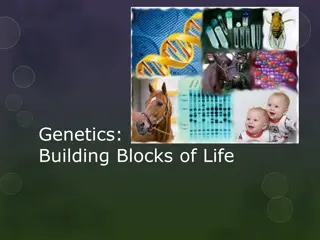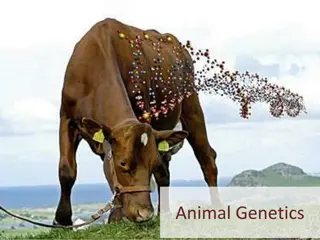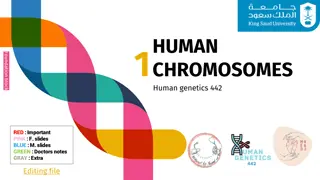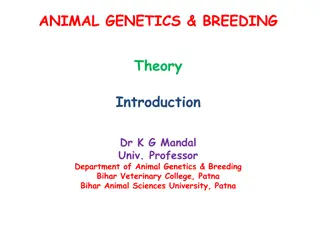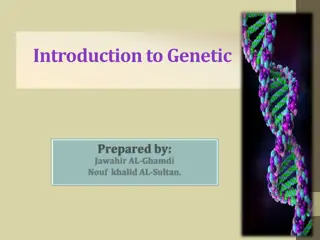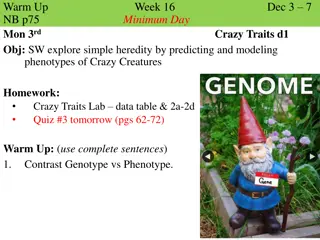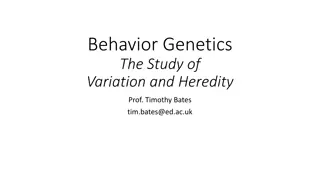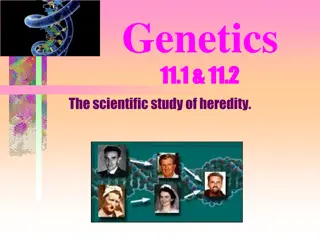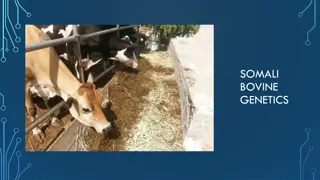The Importance of Heredity and Genetics
Exploring the essential concepts of heredity and genetics, this content delves into the interplay between nature and nurture, the role of genetic code and DNA, and the mechanisms of inheritance. It highlights how genes influence behavior and the distinction between genotype and phenotype. Through visuals and concise explanations, the content provides valuable insights into the intricate world of genetics.
Download Presentation

Please find below an Image/Link to download the presentation.
The content on the website is provided AS IS for your information and personal use only. It may not be sold, licensed, or shared on other websites without obtaining consent from the author.If you encounter any issues during the download, it is possible that the publisher has removed the file from their server.
You are allowed to download the files provided on this website for personal or commercial use, subject to the condition that they are used lawfully. All files are the property of their respective owners.
The content on the website is provided AS IS for your information and personal use only. It may not be sold, licensed, or shared on other websites without obtaining consent from the author.
E N D
Presentation Transcript
Importance of Heredity A BRIEF INTRO TO GENETICS
Nature Nurture issues come back AGAIN! Which is more important: Nature: innate, biological, what you are born with Nurture: environmental experiences that shape your brain (including in utero experiences) Genetics vs experience Do your genes guide your experience? Can experience actually change your genes? Which contributes more to who you are?
Quick review: What is your Genetic Code Gene: biological unit that directs cellular processes Transmits inherited characteristics Typically found in chromosomes Chromosomes In humans: each cell has 46 chromosomes arranged in 23 pairs 23rdpair = sex chromosomes Each set of 46 chromosomes distinct from all others- even in identical twins! Sperm, eggs carry only 23 chromosomes: if put together- get the 46! Each chromosome carries unique set of information that makes you who you are
DNA: Watson and Crick (1953) Deoxyribonucleic acid or DNA Double stranded chain of chemical molecules Forms a double helix Forms rungs, like on a ladder (that s the double helix!) Each rung is composed of 2 of 4 bases: Adenine: A Thymine: T Guanine: G Cytosine: C Order that they are put together is unique for every person Genes influence most of our behavior Not cause, but influence Provide directions for making proteins Proteins = catalyst for making body parts and enzymes Enzymes = catalyst for modifying chemical reactions in body and particularly the brain!
Inheritance Chromosomes are paired, so genes are also paired Allow inherited traits Genotype: actual inherited trait Phenotype: expression of that trait Dominant gene effects One gene dominates the other If you have that gene, it will be expressed Recessive gene effects: Takes two of the genes for effect to be expressed OR is x-linked or sex linked If only get that one, then it is expressed Carried and passed on by the mother
Examples of Inheritance Autosomal dominant Gene Recessive Gene Trait:
Blood type inheritance: Slightly different inheritance If someone has blood type A, they must have at least one copy of the A allele, but they could have two copies. Their genotype is either AA or AO. Similarly, someone who is blood type B could have a genotype of either BB or BO. Blood type Possible genotypes A B AA or AO BB or BO A blood test of either type AB or type O is more informative. Someone with blood type AB must have both the A and B alleles. The genotype must be AB. Someone with blood type O has neither the A nor the B allele. The genotype must be OO Blood type Possible genotypes AB O A B AB OO AA or AO BB or BO Question: Could a mother with type A blood and a father with type B blood produce a child with Type O ? How?
Genes cause behavior? Well, maybe..! Animal breeding studies: can breed for several kinds of traits Physical traits Behavioral traits But genetics not explain the WHOLE picture! Not sure to what degree behaviors such as intelligence, mental illness, addiction are inherited or are environmentally elicited.
Genes cause behavior? Well, maybe..! Look at disorders in dogs: The Merle Coloring Gene Merle = patterned coloring Tricolored or bicolored: Dog is black/white or red/white or black/white/red Merle pattern: diffuses these colors so is more spotted To get a Merle pattern dog: Breed a Merle to a Tri or Bicolored: M M MM colored M MM Mm two merles m Mm two bi
Genes cause behavior? Now: What if breed two merle with a tri with a merle gene? Or two merles? M m m m m Mm mm m Mm mm m mm mm m mm mm Great, right? They are all merles (and I make lots of money) But wait: mm produces: Deafness Underdeveloped eyes Dogs are blind, deaf or both! So, playing with color produces side effects!
Genes cause behavior? Well, maybe..! Human Genome Project also may help understand relation between behavior and genes Goal: map the location of all genes on the human chromosomes and determine genetic codes: order of the bases on each gene Only have approximately 20,000 functioning genes- about as many as a roundworm 97% of DNA does not encode proteins- appear to be junk Genetic research investigates role of genes in behavior Fragile X Huntington s disease Bigger question: Is heredity a destiny or a predisposition?
Side trip to understand importance of inheritance A BRIEF INTRO TO EVOLUTION
Our bodies change over time: Evidence for evolution Charles Darwin (1809-1882): 1859 book: Origin of Species argued species originated from other species and eventually become distinct from their ancestors thus: many animals have common, but very distant, ancestors Evidence from domesticated plants and animals breeding programs; hybrid plants, purebred dogs, cats, etc. Great similarity in body parts across animals: paws, arms, etc. embryology: most embryos look HIGHLY similar Fossil records:
Natural Selection: Darwins 5 major premises: Members of particular species have characteristics that vary Some of these variable characteristics are passed on from parents to siblings Some of these variable characteristics aid survival Species produce more offspring that survive to become adults Characteristics that aid survival will become more common across generations, those that impede survival will die out.
Heritability Heritability = percentage of variation in a characteristic that can be attributed to genetic factors Identical twins versus fraternal twins Intelligence about 50% 60-90% heritability for schizophrenia 40-50% for personality characteristics 90% for height Appears about of differences in behavioral characteristics are due to heritability Rest must be due to environment or interaction of genes and environment Vulnerability: genes contribute to predispositon for disorder Must exceed required threshold to elicit disorder Diathesis stress model Takes both genetic predisposition AND stress to elicit certain mental disorders such as schizophrenia
Most important take home lesson: Our brain controls behavior AND Behavior changes our brain Two way street Interactions These interactions are explainable and able to be scientifically studied. Genetic traits are important We inherit dispositions, not inevitabilities. Genes must interact with environment Not what WILL happen, but what COULD happen Takes an eliciting stimulus to turn on/off the gene
Practice Quiz Questions: Who showed that nerves operate cannot operate like an electric wire because that would be too slow? a) Hermann von Hemmholtz b) Rene DesCartes Wilhelm Wundt d) Paul Broca c)
Practice Quiz Questions: The idea that specific areas of the brain carry only one specific function is called__________. a) localization and has shown to be incorrect. b) localization and has shown to be correct. specialization and has shown to be incorrect. d) specialization and has shown to be correct. c)
Practice Quiz Questions: A proposed mechanism for how things work is called a _______________. a) Theory b) Mechanism Model d) Predisposition c)
Practice Quiz Questions: Extra Credit Question: A person has a gene that is linked with a disease, but he or she does not have the disease. The book mentions several reasons why this could occur. Describe two of them.




